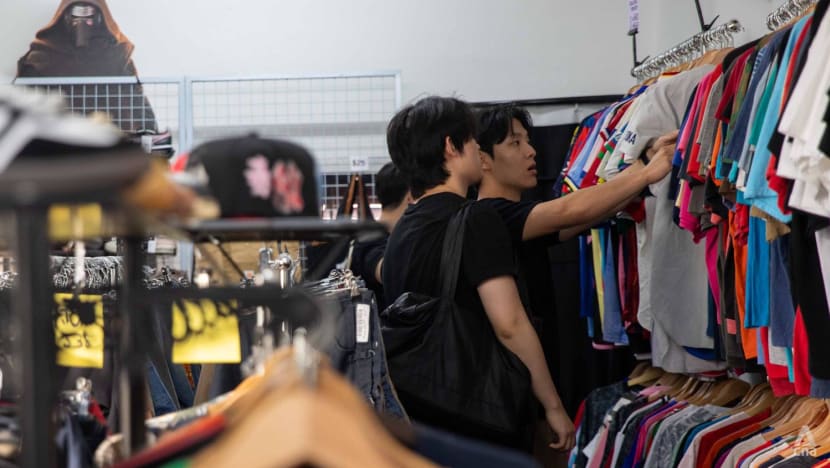Commentary: Is underconsumption the new consumption? It depends
"Underconsumption core" continues to trend on TikTok, but is choosing frugality a conscious act, or just a performance? The difference is up to us, says sociologist Terence Heng.

Customers browsing items at a thrift shop on Jul 18, 2024. (Photo: CNA/Lim Li Ting)

This audio is generated by an AI tool.
LIVERPOOL: I am probably going to betray my age by saying this - I don’t see why full-length socks are back in fashion, especially when wearing shorts.
It just looks weird, and even more so when combined with open-toe sandals. I’m told to pull up my socks, but I can’t because, well, they’re ankle-length.
This is not just a lack of fashion sense. It seems I’ve finally reached that point when the cai fan aunty calls me “uncle” (no more “shuai ge” for you, Terence), and conversations with friends turn to ElderShield, progressive spectacle lenses, and of course, whether we have enough money to retire.
The last point though, about having enough money, is admittedly an intergenerational concern. The older generation worries about retirement, but the younger generation often worries about day-to-day survival. Can they afford mortgage payments, rent, university fees, childcare, elderly care - or even lunch?
This is not just a Singaporean concern. In the United Kingdom, a significant proportion of university students are working longer part-time hours to supplement already inadequate tuition fee loans in the face of rising costs of living. This doesn’t just affect their social life, but their learning journey as well.
And despite inflation seemingly slowing around the world and central banks starting to cut interest rates, goods and services are still much more expensive than they were a few years ago. Things just keep getting more expensive, and people keep getting more worried and even upset, like when Toast Box decides to raise the price of its kaya toast set.
So, it is no surprise when one of the newer trends on Tiktok is about finding ways to spend and consume less.
NO SURPRISE TO THE OLDIES
Better known as “underconsumption core”, TikTokers film themselves being frugal by having only one reusable Stanley water cup, making use of old clothes (rather than constantly buying new ones), and, this is important, looking the part.
The term “core”, as explained in The Guardian, means the trend also takes on a certain kind of frugal aesthetic. The same article also points to the contradictions of not consuming, but having to consume in some way to look like one is underconsuming (more on this later).
Every generation thinks that they have stumbled onto something new and innovative, but soon realises that it’s mostly been done before. With underconsumption core, I doubt that anyone Gen X and older will bat an eyelid.
Wear your clothes to death (and beyond)? Sure! Buy second hand? Definitely! Make use of every part of your groceries/leftovers? Of course! That’s what fried rice is for - everything can go in. E-ve-ry-thing.
This may, and probably does sound like one of those “we only ate chicken during Chinese New Year” or “your great-grandfather slept in a hearse” moments (both of which, might I add, are true stories), but if restricting yourself to one designer-esque reusable mug is considered underconsumption, I do not want to know what overconsumption looks like in this paradigm.
IS IT JUST NORMAL CONSUMPTION?
Gen Z is not entirely oblivious to the irony of underconsumption core, as some have also termed it “normal core”, recognising that we have, as a society, been taking the whole “buy now regret later” ethos a little too seriously.
Some have noted that underconsumption is also a reflection of and reaction to the times we live in. It’s not just because many of us are acutely affected by inflation and the constant (and frightening) rises in costs of living, it’s also because we sense that the pendulum inevitably needs to swing back a little bit from the extreme end of making material wealth an indicator of living one’s best life.
It would be wrong to dismiss material goods as simply a status indicator. Sociologists and social researchers will tell you that buying things is about more than ownership - it’s about being able to assert and demonstrate that one is able to control and curate one’s life. That’s why mid-life crises often revolve around overspending in one way or another.
In other words, lifestyles that purport to consume less - not just underconsumption, but asceticism, thriftiness and minimalism - are also human attempts to find control in curatorship. Pushing back against excess isn’t new; the terms just change with the times.
MAKING GOOD OUT OF MAKING DO
Underconsumption core also has an environmental ethos to it, in that it demonstrates an awareness of what throwaway cultures, fast fashion and “use-once” practices are doing to the earth. If underconsumption can make recycling and upcycling even more popular, that’s a good thing.
One thing that bothers me though, is the “looking the part” bit. If we’re trying too hard to simply be part of the trend, we undermine the whole point of the exercise. This is because anything performative requires effort, and effort often requires us to use resources.
Are we really underconsuming, or just showing off some kind of alternative consumption ethos? If we’re going out to buy more clothes to cosplay our thriftiness, then that’s not really underconsumption, even if our new threads are second hand.
The trick, and key tenet of true underconsuming, is to make do or do better with what you currently have, and only replace what’s unusable, worn out or broken beyond repair. Underconsumption - or just normal consumption - requires practices that overconsumption does not: Self-discipline and restraint, especially in a consumerist world where someone is always trying to sell you something.
Terence Heng is senior lecturer in sociology at the University of Liverpool.




















